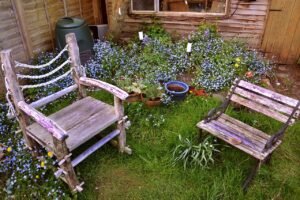Best Gardening Tips for Beginners
![]()
What is more, gardening can become one of the most enjoyable and fulfilling activities, helping to cultivate new types of vegetables and lovely flowers and spending time in the fresh air. For beginners, it may seem quite daunting, but you should be fine. With proper attitude and techniques, you can grow a beautiful garden within no time. Whether you have a large backyard or a few pots on your balcony, these tips for a beginner gardener will help.
1. How to Begin with Small and Easy Plants
It often happens when beginners get carried away with garden ideas and plant almost all the plants that they come across. But that way, you will not be overwhelmed, and starting with a small garden that is easier to manage is good. If you are new to gardening, then do not try to cultivate many types of plants at once in a large area; instead, you can try planting a few types of plants in a small area, like a small garden bed or a few pots so that you will not get frustrated.
Select plants that don’t demand a lot of care and maintenance, such as tomatoes, lettuce, marigolds, or basil. This will also allow one to determine the environmental factors that nurture growth, such as the amount of light that the area receives and the drainage ability of the soil.
2. Understand Your Garden’s Conditions
In gardening, there is probably no other activity more critical than knowing the growth conditions in your garden. First, pay attention to the plot you have decided to occupy. How many hours of light does the place get in your garden on average daily? Most plants require direct sunlight for at least 6 hours, while flowers and vegetables and some plants such as lettuce and hostas require shade.
Soil is another crucial variable. Vegetation, soil, slope, aspect, elevation, land cover, vegetation density, slope length, and slope steepness can be classified as essential factors or variables influencing water yield. To achieve this, the gardener must ensure that the soil he works with is healthy. Sally, test the soil so you will know the pH level of the soil together with the nutrients that are available and if you will need to add some nutrients in the form of compost or any other organic material. Good soil should also be grainy and well-drained and contain many organic matter.
3. Plan Your Garden Layout
Properly arranging plants in the garden also increases the likelihood of your plants growing in the best manner since they have adequate space, light, and air. Firstly, determine if you wish to carry out gardening directly on the soil, using a berm, or going for a container garden. Every option has its advantages. For instance, using raised beds allows you to easily manage the soil quality you want to use, while containers are best used in areas of limited space and can be relocated anywhere required.
When designing a garden, one should plant the plants at the required distance indicated on the seed packets or the plant tags. Sheltered plants are much more vulnerable to diseases and pests due to a lack of space, which entails weak airflow. Space also sometimes allows each plant to stretch and develop without struggling with other plants for scarce resources such as light, water, and soil nutrients.
4. Choose the Right Plants for Your Climate
Choosing the right plants that would fit the climate zone in which one lives is critical to enhancing one’s chances of success. There are plants that will grow best in a warm environment, while others prefer cooler climates. You have to determine your hardiness zone before purchasing seeds or plants, as this depends on the average of your location’s annual minimum temperature. This knowledge will enable you to select plants with better chances of growing in your climate.
For instance, if you reside in a hot and dry area of the country, you will opt for plants that can survive high temperatures, such as lavender, rosemary, or even succulents. If you are positioned in a cooler climate, then spinach, carrots, and peas can do the trick.
5. Water Your Plants Wisely
Irrigation is one of the most crucial and, simultaneously, one of the most challenging processes in gardening. It is also important not to overwater or underwater the plants as both conditions are detrimental to plants. The rule of thumb is to water more but less often, allowing the root system to soak up water to the deepest part of the soil. This helps the roots extend more into the ground and, in the process, makes the plant stronger as it develops.
Usually, most gardens should receive approximately an inch of water in one week, depending on the kind of plants, the type of soil, and the prevailing climate. To prevent over-watering plants, the sub-surface should be tested by inserting the finger into the second knuckle. By touching it, it is straightforward to know if it is time to water it or not; if it is dry.
6. Use Mulch to Retain Moisture and Prevent Weeds
Any gardener will attest that mulch is their greatest treasure since it retains moisture and suppresses weeds. Learn how to maintain your garden by putting organic mulch on the plants to maintain moisture in the soil, moderate soil temperature, and suppress weed growth. Mulch also adds beauty to your garden since it provides a neat and complete appearance to the area you have cultivated.
The different forms of mulch used are straw, wood chips, grass clippings or shredded leaves, and many others. Apply the mulch to a 2-3 inches thickness around plants, but do not place it on the stem area to avoid rotting.
7. Avoid Hurrying and Try to Pollard Occasionally and Check on Your Garden Often
This is a classic Conservative gardening remark: observing and waiting takes as much time as digging and reaping. As a beginner, you won’t be an expert in plant care, but you will learn something as you watch them grow and respond to various conditions. Devote a few minutes daily or every few days to strolling around your garden, looking for any signs of pest attacks, and ensuring the plants are healthy.
Identify if your plants are in distress: The leaves may be yellow, plants may be dwarfed, or they may be infested with insects. Eliminate a problem as soon as you discover it and before it becomes large. Irrigating, weeding, and pruning, or rather adjusting the plants within the garden, will also play a big role in maintaining the garden.
Gardening is one of the activities that requires patience because plants do not grow overnight. It will take some time for a person to become comfortable with the process, but the more one is involved with the garden, the more rewarding it becomes.
Conclusion
Gardening is a process that starts with making several perfect decisions concerning the actions to be taken. Beginning with the kinds of plants, the nature of the garden, the positioning of the plants, the selection of plants according to the climate, watering, mulching, and patience will all lay the foundation. By doing so, you get to enjoy the art of coming up with a green finger, even though growing greens might take some time. By following the tips above, one is on the right path to a healthy, lush garden. Happy gardening!
To read more about Essential Gardening Tips for Beginners and Experts. click here.




